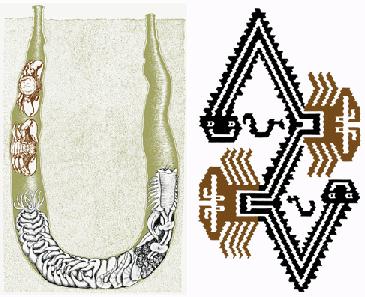
© Seibt & Wickler
| Ikonography of a zoomorphic design Ikonographie von zoologischen Design |
back to Seibt |
| The "double-headed snake" ("serpiente dentada", "Zackenschlange") is one of the commonest, and ostensibly mythical, animal figures depicted on pottery and textiles of coastal peoples from ancient Peru between 2000 BC and 1500 AC. Applying methods of comparative morphology to the various pictorial forms of this animal we discovered its key characteristics and identified it as a marine annelid worm, class polychaeta. | |

© Seibt & Wickler |
One of the oldest available textile fragments from Peru, dated 2000-1800 BC, shows the supposed double-headed snake with two appended crabs (right). This illustrates the common combination of a 'sandworm' polychaete with a pair of porcellanid crabs, living together in the worm's burrow (left). The worm-crab motif seems to be the oldest known illustration of a symbiotic relationship among invertebrates. | The significance to people may have originated from the polychaete worms' very conspicuous reproductive swarming that is strictly coupled to lunar periodicity and makes them excellent 'calender worms'. |
Literature
Wickler, Wolfgang & Seibt, Uta 1998: Kalenderwurm und Perlenpost. Biologen entschlüsseln ungeschriebene Botschaften. Spektrum Akademischer Verlag, Heidelberg, Berlin pp. 217
Wickler, Wolfgang & Seibt, Uta 1988: A crab-polychaete symbiosis from ancient Peruvian iconography, and the "sawtoothed snake" problem. Baessler-Archiv Neue Folge 36, 253-259
Wickler, Wolfgang & Seibt, Uta 1983: Die alt-peruanische "Zackenschlange": Ein ikonographisches Mi▀verständnis. Baessler-Archiv Neue Folge 31, 283-298